Silent Era Home Page > Home Video > Presenting Felix the Cat

Reviews of silent film releases on home video.
Copyright © 1999-2025 by Carl Bennett
and the Silent Era Company.
All Rights Reserved. |
|
Presenting
Felix the Cat
The Otto Messmer Classics
(1919-1924)
|
Contents: Paramount Magazine [Feline Follies] (1919), Felix in the Swim (1922), Felix Lends a Hand (1922), Felix Minds the Kid (1922), Felix Saves the Day (1922), Felix in the Bone Age [listed here as “Felix the Stone Age”] (1922), Felix Gets Broadcasted (1923), Felix Goes a-Hunting (1923), Felix in Fairyland (1923), Felix in Hollywood (1923), Felix Revolts (1923), Felix the Ghost Breaker (1923), Felix Wins Out (1923), Felix Finds ’em Fickle (1924), Felix Out of Luck (1924) and Felix Turns the Tide (1924).
Felix the Cat was created by Pat Sullivan, but was largely the work of Otto Messmer, the man who animated the films and drew the newspaper comic strips. According to the introduction to this Bosko Video program, Messmer directed and animated more than 175 Felix cartoons in the years 1919 through 1929. During that time, Felix the Cat was one of the world’s most-popular animated characters, with several short films in circulation at any one time throughout the 1920s and a profitable line of Felix the Cat merchandise.
Despite Felix’s high popularity, he died a quick death as a movie star when Sullivan refused to enthusiastically transition his meal ticket character to sound films. Some of the silent cartoons were rereleased with new product featuring poorly recorded and poorly synchronized sound effects by Copley Pictures Corporation in 1930, but it was too late. Disney’s Mickey Mouse was the new reigning king of the cartoon short. Pat Sullivan’s wife may have committed suicide or accidently fallen from a hotel window in February 1932; Sullivan’s own death came a year later from alcoholic complications — two tragic deaths brought about by the end of Felix’s motion picture career. However, it was animator Otto Messmer, the man who knew Felix best, who benefitted in the long run, for he continued drawing Felix for the Sunday papers until 1943 and continued the daily strip until 1967. Messmer died at the age of 91 in October 1983.
— Carl Bennett
|
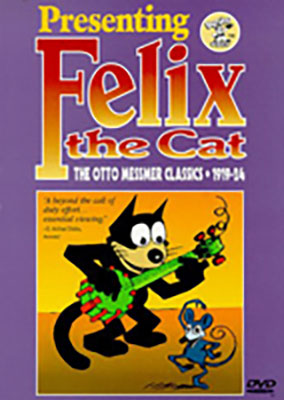 Bosko Video Bosko Video
1999 DVD edition
Presenting Felix the Cat: The Otto Messmer Classics 1919-1924 (1919-1924), black & white and color-tinted black & white, 119 minutes total, not rated, including Paramount Magazine [Feline Follies] (1919), black & white, ? minutes, not rated, Felix in the Swim (1922), black & white, ? minutes, not rated, Felix Lends a Hand (1922), black & white, ? minutes, not rated, Felix Minds the Kid (1922), black & white, ? minutes, not rated, Felix Saves the Day (1922), black & white, ? minutes, not rated, Felix in the Bone Age [listed here as “Felix the Stone Age”] (1922), black & white, ? minutes, not rated, Felix Gets Broadcasted (1923), black & white, ? minutes, not rated, Felix Goes a-Hunting (1923), black & white, ? minutes, not rated, Felix in Fairyland (1923), black & white, ? minutes, not rated, Felix in Hollywood (1923), black & white, ? minutes, not rated, Felix Revolts (1923), black & white, ? minutes, not rated, Felix the Ghost Breaker (1923), black & white, ? minutes, not rated, Felix Wins Out (1923), black & white, ? minutes, not rated, Felix Finds ’em Fickle (1924), black & white, ? minutes, not rated, Felix Out of Luck (1924), black & white, ? minutes, not rated, and Felix Turns the Tide (1924), black & white, ? minutes, not rated.
Bosko Video, distributed by Image Entertainment, ID5532BKDVD, UPC 0-14381-55322-2.
One single-sided, single-layered, Region 0 NTSC DVD disc; 1.33:1 aspect ratio picture in windowboxed 4:3 (720 x 480 pixels) interlaced scan image encoded in SDR MPEG-2 format at 3.0 Mbps average video bit rate (capable of progressive scan upscaling to ? fps); Dolby Digital (AC3) 2.0 stereo sound encoded at 192 Kbps audio bit rate; English language intertitles, no subtitles; chapter stops; snapper DVD case; $24.99 (reduced to $9.99).
Release date: 20 April 1999.
Country of origin: USA
Ratings (1-10): video: 6 / audio: 9 / additional content: 6 / overall: 7.
|

This DVD collection by Bosko Video dates to its original release in two VHS videotape volumes in 1993. All of the films are presented in windowboxed transfers that appear to be from prints that could be anything from 35mm prints to 16mm and 8mm reduction prints. Some of the films in the second volume are compromised by a minor video master glitch at the top of the frame.
The film commonly identified as Feline Follies (1919) was actually a segment of the Paramount Magazine, a semi-weekly compilation of short film segments that included animated cartoons. It appears that the entire issue has been included here, or that only the animated segments have been presented, for the issue includes three animated segments beginning with Earl Hurd’s Bobby Bumps in “Their Master’s Voice,” continuing with “Feline Follies,” and ending with Bud and Susie in “Down the Mississippi” by Frank Moser. The film appears to be transferred from more than one 16mm reduction prints that range from good to very good. The prints are worn and have long vertical emulsion scratches. The transfer has an annoying wandering frameline that occasionally moves throughout the film. The source print and the transfer have been over-cropped since during “Feline Follies” all of a word balloon is unreadable until the frameline in the transfer is adjusted to reveal the partially cropped balloon. At best, “Feline Follies” is merely the germination for Felix since it is Pat Sullivan’s one-off examination of an amorous tom cat named Tom. The closest attribute of Tom’s to Felix is his expressive tail that changes to a question mark when he is called.
Felix Saves the Day (1922) features Felix as a last-minute baseball hero. The film is transferred from a very good reduction print. In Felix in the Swim (1922) Felix and Willie run off to their favorite swimming hole; transferred from an excellent print. Felix Turns the Tide (1924) features Felix as a cat and rat war hero; transferred from a very good print. In Felix Lends a Hand (1922) Felix travels to Egypt to rescue a woman from a sheik; transferred from an excellent print. In Felix Minds the Kid (1922) Felix is the sitter for a troublesome toddler; transferred from a poor print. Felix in the Bone Age [listed here as “Felix the Stone Age”] (1922) features Felix as the target of a fur-seeking caveman; transferred from a poor and incomplete print, which includes one shot from a Felix cartoon from the late 1920s.
Felix the Ghost Breaker (1923) features Felix as a rural ghostbuster. The film is transferred from two good and very good reduction prints. In Felix Wins Out (1923) Felix joins a travelling circus and gets even with its impressario; transferred from a good print. In Felix Revolts (1923) a starving Felix leads a cat rebellion against the town’s council; transferred from a good print. In Felix Gets Broadcasted (1923) Felix gets sent via radio to Egypt; transferred from a very good yellow-tinted print. Felix in Hollywood (1923) features Felix in one of his best-known films as an film-acting hopeful; transferred from two prints that range from good to very good. Felix in Fairyland (1923) features Felix as a traveller to a storybook fantasy land; transferred from a good print. In Felix Out of Luck (1924) Felix is again starving and goes through a number of attempts to find something to eat; transferred from a good print. In Felix Goes a-Hunting (1923) a harridan wife insists on a fur coat and Felix becomes the husband’s game hunter; transferred from an excellent print. In Felix Finds ’em Fickle (1924) a redesigned Felix character learns that it’s hard to please a woman; transferred from a very good print.
Several of the films have been reconstructed from more than one print. Some feature only the ending title card from another print, some use more than one print to present as complete a version of the original cartoon as possible. All are likely transferred from the best surviving prints although the majority of them are 16mm reduction prints.
The films are accompanied on a Wurlitzer theater pipe organ with score arrangements performed by Dave Wickerham. The Wurlitzer is impressively put through its paces and the music has been well-recorded in stereo.
While the prints in this collection aren’t the best, and some of them can be hard to watch, this disc is of value for the sheer number of Felix the Cat cartoons it contains and the excellent musical accompaniment.
|
This Region 0 NTSC DVD edition has been discontinued
and is . . .
|

|
|
|
Other ANIMATION FILMS of the silent era available on home video.
|
|

LINKS IN THIS COLUMN
MAY TAKE YOU TO
EXTERNAL WEBSITES
•
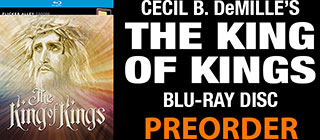
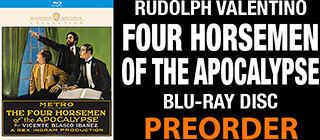



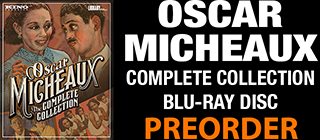
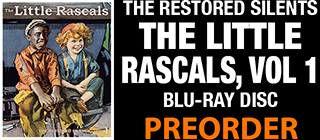


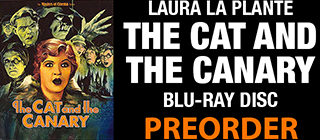


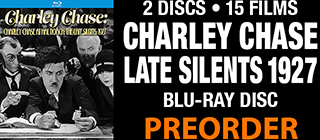
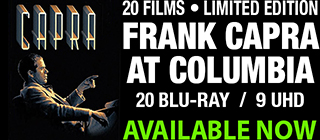







•
|




































